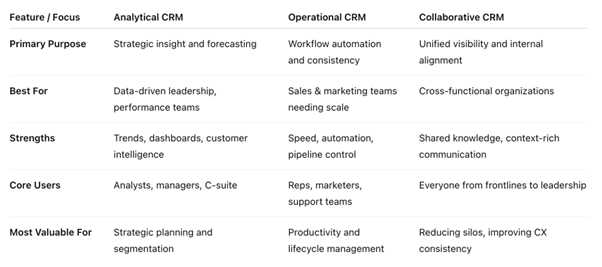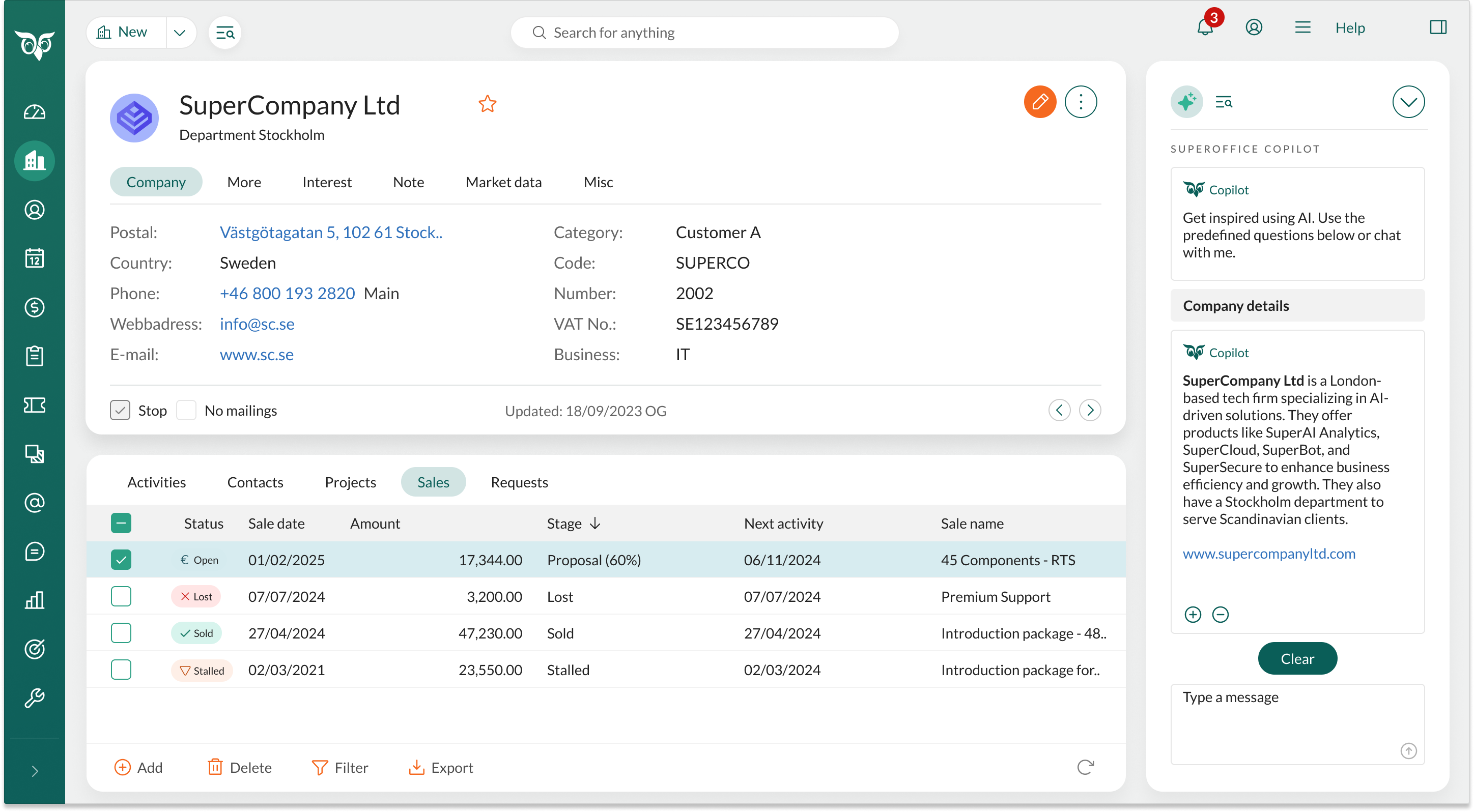When it comes to choosing a CRM, most businesses start with the same question:
What can it do?
But the better question is:
What kind of CRM does your business actually need?
Some CRMs are designed to surface insight. Some are built for automation. Others are built to connect people, teams, and processes. And while all of them manage contacts and track activities, their real value lies in how well they align with the way your business sells, serves, and grows.
In this article, we’ll walk through the three core types of CRM - analytical, operational, and collaborative - and explore what each does best.
You’ll see how they differ, where they overlap, and why more companies are turning to unified platforms like SuperOffice that combine all three into a single system.
But, before we dive into the details, it helps to understand the three distinct types of CRM - and what each is built to do.
The 3 Types of CRM

Every CRM falls into one (or more) of these categories:
- Analytical CRM → Focused on using data to drive smarter decisions
- Operational CRM → Built to automate workflows and streamline day-to-day execution
- Collaborative CRM → Designed to break down silos and align teams around the customer
Each type supports a different business need - but the most effective platforms bring them together in one system.
Let’s take a closer look at what that means in practice.
1. Analytical CRM: Make Smarter Decisions with Data
Every business has data. But few turn that data into decisions.
That’s where an analytical CRM comes in. Instead of just recording activity, it helps you understand what’s happening, why it’s happening, and how to act on it. Think of it as a strategic intelligence layer for your customer relationships.
In mid-sized B2B organizations - where deal cycles are long and sales involve multiple touchpoints - understanding trends is more valuable than tracking transactions.
An analytical CRM gives you that perspective. You’re not just logging closed deals - you’re spotting why they close, when they stall, and what influences customer behaviour.
From a sales perspective, this means surfacing insights like:
- Which types of companies are most likely to buy
- Where in the pipeline deals are most likely to drop off
- Which reps are consistently winning - and why
For marketers, analytical CRM helps prove campaign ROI, compare lead sources, and optimize segmentation based on actual engagement - not assumptions.
And for service teams, it highlights patterns in support volume, resolution times, and customer satisfaction.
These insights don’t just live in reports - they shape smarter, more confident decisions. That’s why 72% of CRM adopters say the ability to track more customer interactions is a core reason they invested in CRM in the first place.
In fact, companies that actively use analytics in their decision-making are 5x more likely to act faster than competitors - turning insight into impact before the window closes.
Popular analytical CRM tools include Salesforce, Insightly, and Zoho Analytics. With SuperOffice, these insights come built in. Sales dashboards, campaign performance, pipeline velocity - it’s all visible and actionable, without extra tools or integrations.

2. Operational CRM: Scale Smarter with Automation
For many companies, the first CRM need is tactical: "How do we stay on top of leads, follow-ups, and tasks without things slipping through the cracks?"
That’s the job of an operational CRM - to make day-to-day work faster, more consistent, and less manual. It’s the engine that keeps your pipeline moving, your campaigns flowing, and your service requests under control.
That’s why 66% of high-performing sales teams use CRM automation to streamline their sales cycle - minimizing friction and maximizing speed across every stage of the funnel.
In B2B organizations where small teams handle large pipelines, operational CRM is often the difference between growth and chaos.
It automates what shouldn’t require human effort: follow-up reminders, lead assignments, email sequences, and case escalations. And it ensures your team always knows what needs to happen next.
For example:
- A new lead fills out a form → They get an automated, personalized email
- A prospect books a meeting → Your sales rep is notified, and the task is logged
- A service ticket goes unresolved for 48 hours → It’s automatically flagged and escalated
The result? Faster response times, fewer missed steps, and more time for your team to focus on relationships - not admin work.
It’s also where most companies begin to feel the ROI of CRM: not just in productivity, but in outcomes. CRM users who automate follow-ups see up to a 47% increase in conversion rates. That’s because timing matters - and manual systems rarely get it right.
Tools like HubSpot and Pipedrive are popular in this space. With SuperOffice, operational efficiency is native. From form fills to automated nurture flows to follow-up tasks, it’s all part of the same system your sales and marketing teams already use - no extra modules, no duct-taped add-ons.
Tired of juggling tools and spreadsheets? Book a demo to see how automation can save your team hours each week - and help you scale with less effort.
3. Collaborative CRM: Align Teams, Deliver Seamless Experiences
Most businesses think of CRM as a sales tool.
But your customers don’t see your departments - they see one brand.
That’s why a collaborative CRM exists: to break down internal silos and make sure every part of your business is aligned around the customer.
And it matters - 86% of customers say poor internal communication is the top reason they leave a brand. A shared view of the customer isn’t just operationally helpful - it’s critical for retention.
From the first touchpoint to renewal - and every conversation in between - collaborative CRM helps you deliver a consistent customer experience.
This is especially important in B2B companies where deals often span multiple departments, involve long implementation periods, and require ongoing support.
Without shared visibility, things fall through the cracks. Sales hands off to service with little context. Marketing promotes offers to unhappy customers. The left hand doesn’t know what the right hand promised.
A collaborative CRM prevents that. It gives everyone - from sales to marketing to support - a unified view of each customer’s journey.
Past purchases, support history, email interactions, and deal notes are all available in one place. That context builds trust, reduces frustration, and leads to stronger, longer relationships.
The benefits go beyond internal efficiency. Businesses that align teams through CRM are 2.5x more likely to see ROI from their CRM investment. That’s because alignment isn’t just a process win - it’s a customer win.
Well-known collaborative platforms include Dynamics 365 and Sage CRM. But with SuperOffice, this collaboration is built into the core. Every department sees the same customer record, complete with real-time activity updates, shared notes, and engagement history - so handoffs feel seamless and aligned, every time.
When teams are aligned, customers notice. Explore SuperOffice CRM to see how shared insight leads to better experiences - and better outcomes.
CRM Comparison: Which Type Is Right for You?
No CRM type is better than the others - they just serve different needs.
Some are built to drive decisions. Others to increase efficiency. As you’ll see below, each CRM type has strengths. But platforms like SuperOffice are built to bring those strengths together in one intuitive, unified environment:

Not sure what kind of CRM your business needs? Talk to a CRM expert to explore which capabilities fit your goals, team size, and strategy.
Why Choose Just One Type - When You Can Have All Three?
Most CRM systems specialize in one strength. But modern businesses don’t operate in silos - and your technology shouldn’t either.
SuperOffice CRM combines the best of all three CRM types into a single platform built for mid-sized B2B companies.
- Need reporting and forecasting? SuperOffice gives you customizable dashboards, pipeline analytics, and customer insights - all out of the box.
- Want to automate campaigns, follow-ups, and service tasks? You can do that, too - with intuitive tools built for marketers and salespeople.
- Looking to improve handoffs between teams? SuperOffice gives everyone a shared view of each customer, so nothing gets lost between departments.
And unlike many CRM suites that bolt on features over time, SuperOffice was built from the ground up with consistency in mind. That means one UI, one logic model, and one source of truth - making onboarding easy and adoption frictionless.

The Best CRM Supports How You Actually Grow
Your CRM should reflect how your business works - not the other way around.
- If you need clearer data to make better decisions → Choose Analytical
- If you need to automate and scale without more headcount → Choose Operational
- If you need to unify teams around the customer → Choose Collaborative
- If you need all three → Choose SuperOffice CRM
It’s not about features. It’s about fit.
Ready to see it in action? Book a 30-minute demo and we’ll show you how SuperOffice CRM connects your data, your processes, and your people to drive long-term growth.




